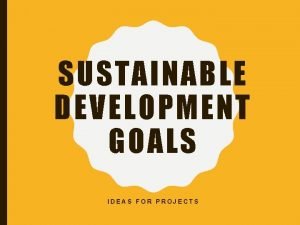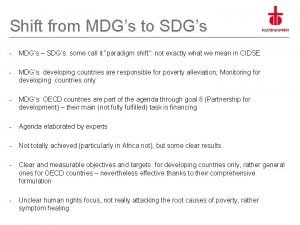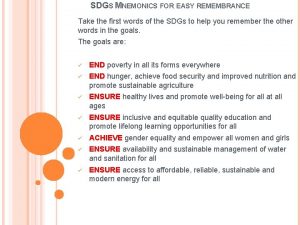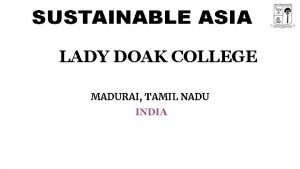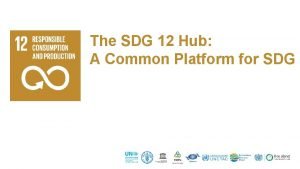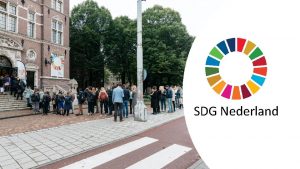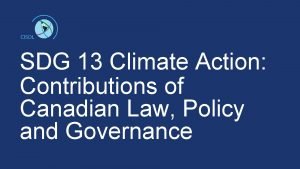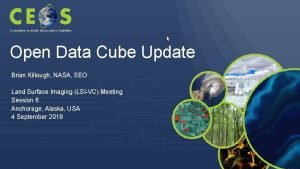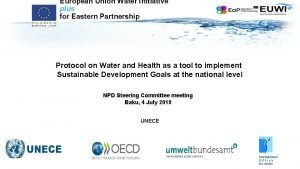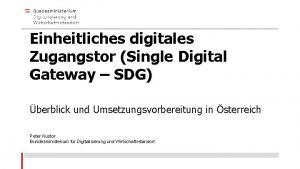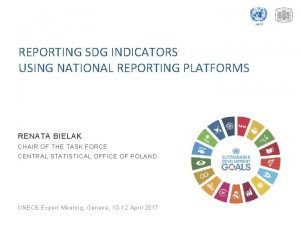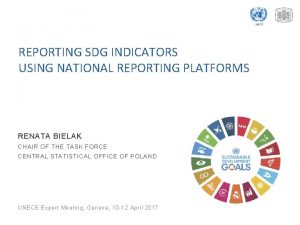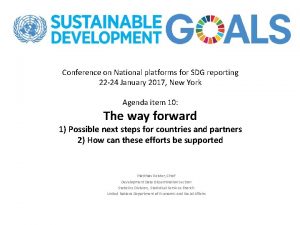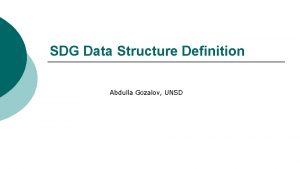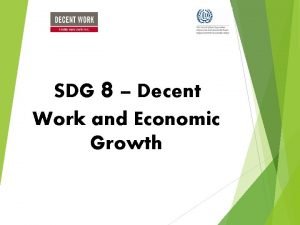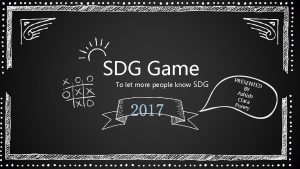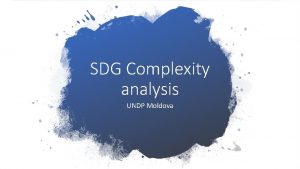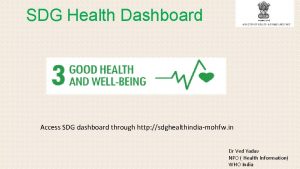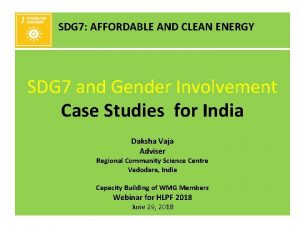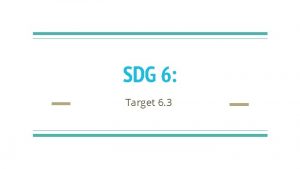REPORTING SDG INDICATORS USING NATIONAL REPORTING PLATFORMS RENATA













- Slides: 13

REPORTING SDG INDICATORS USING NATIONAL REPORTING PLATFORMS RENATA BIELAK CHAIR OF THE TASK FORCE CENTRAL STATISTICAL OFFICE OF POLAND UNECE Expert Meeting, Geneva, 10 -12 April 2017

Task Force on reporting SDG indicators § Terms of Reference approved by the CES Bureau in October 2016 § Members: Poland (chair), Canada, Germany, Mexico, Sweden, United Kingdom, United States and UNECE (Secretariat) § The objective – to facilitate the country decision about the national reporting mechanism on global SDG indicators, specifically about the development of National Reporting Platform (NRP) § Created for 2016 -2018 to work in two stages: I. Documentation of NRPs key features and recognition of conditions for developing NRPs - by October 2017 II. Assisting CES countries in replicating best practices on NRPs – by October 2018 2

Basic assumptions § TF work focused on national organisation of reporting mechanisms Ø implementation of the 2030 Agenda, as well as the follow-up and review processes at all levels will be country-led and based on data provided by national statistical systems § NSOs choose the model of reporting indicators best suited to their circumstances and capabilities § Special attention given to NRPs (as one of several possible approaches towards reporting of SDG indicators) 3

What is a National Reporting Platform? § A NRP is a tool to report national statistics for the global SDG indicators § Wider meaning considered by the TF – a NRP as a channel for disseminating national data for SDG indicators § data serve various users (policymakers, custodian agencies, general public) § many practical solutions possible (integrated website, dedicated database, separated data file etc. ) 4

Possible objectives of NRPs § Disseminating of national data (collecting, processing and validation also possible) § Reporting of SDG indicators (to regional or global level) § Monitoring of national priorities § Promoting the 2030 Agenda § Communicating the role of NSOs 5

TF – first outputs § Experience from countries having NRPs gathered (dedicated questionnaire, completed by Germany, Mexico, Poland, US) § Draft documents prepared: ü Description of NRPs The document presents information about NRPs; it is intended to help countries when selecting a mechanism for reporting national statistics for global SDG indicators ü Guidelines for national SDG indicators reporting mechanisms The document discusses the reporting of the global SDG indicators from countries to global level; it aims to assist countries in choosing the most suitable reporting model 6

Description of NRPs - content § Key features of NRPs (considering various possibilities) ― when a NRP could be suitable, ― what features determine that a NRP reaches the goals set § Existing national experiences (summary of practical cases, based on the questionnaire) § Two case studies (complementary to those included in the Road Map) § ― German Genesis database, ― setting up the UK version of NRP basing on US experience Benefits of NRPs and areas to be improved (strengths and weaknesses of NRPs) 7

Country experience with NRPs § Different approaches for developing NRPs § Germany – to combine all reporting needs in Genesis Online database § Mexico – to develop a NRP for SDGs on the pattern of MDGs platform § Poland – to modernise a NRP and extend it from SDIs to SDGs § US – to develop a reporting solution for highly decentralised statistical system § Similar general framework (e. g. using open source licences, presentation of data and metadata) § Differences in detailed solutions (e. g. specific facilities for users) § Considerable advantages of NRPs 8

The suitability of NRPs § Do we need a NRP? § What kind of NRP we need? ― goals to be reached ― target users ― nature and number of indicators to be covered ― statistical capacity (current and planned) § Make use of other countries’ experience and best practices 9

Guidelines - content § Actors of data flows’ – the role of NSOs and international organisations § Types of data in data flows – from official statistics to non-statistical data § Models for national reporting on global SDG indicators – considering possible options for data flows (centralised reporting, decentralised or „mixed” one) § Determinants and arguments to be considered (how to take the decision about the reporting model? ) 10

National reporting model § § Why the decision is important? § The role of NSOs in data flows is clearly defined § All stakeholders know their responsibilities § Well-organised reporting model is crucial for effective monitoring of SDGs What should be taken into consideration? § The role of NSO (the NSO as a country coordinator for SDG indicators) § Organisational model of the statistical system § National reporting mechanisms within the statistical system § Existence (or developing) of national action plan regarding SDGs § Quality assurance mechanisms § Resources available, technical capabilities, … 11

Next steps of the TF Task Further work on draft documents Present the results achieved to the CES plenary session Prepare the final report from the 1 st phase Deadline Mid May 2017 June 2017 September 2017 Report to the CES Bureau October 2017 Develop a work plan for the 2 nd stage of work October 2017 12

Issues for discussion § Are the TF foregoing results helpful? § What other elements should be considered in the documents? § What else could be relevant to the TF work? § Share your country experience/plans re national reporting mechanism 13
